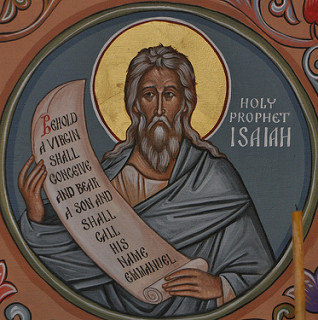You can listen to an audio podcast of this post at https://www.spreaker.com/user/youngfaithradio/esaiasintro2
The Lenten Readings from Esaias
Introduction
Upon approaching the Prophet Esaias and the prophetic books in general, one easily sympathizes with the Blessed Augustine of Hippo when he first attempted to understand Esaias in the early days of his conversion:
Ambrose [St. Ambrose of Milan, Augustine’s mentor] told me to read the prophet Isaiah, I think, because more clearly than others he foretold the Gospel and the calling of the Gentiles. But I did not understand the first passage of the book, and thought the whole would be equally obscure. So I set it aside to be resumed when I had more practice in the Lord’s style of language. – Confessions 9.5.1
We have to admit that few of us Orthodox Christians spend time with the Old Testament in general, and that we find the prophets in particular to be hard going. When we do try to read them, we often have the same reaction that St. Augustine had when he first opened Esaias, and we are tempted to give it up. During and since his time, however, the Lord has providentially raised up for us a glorious band of Holy Fathers to enlighten the meaning of the Scriptures for us, and if we turn to them for help, we shall not be disappointed. They were much at ease with the “Lord’s style of language” because they had acquired the mind of Christ, and therefore what was obscure to unbelievers or to Christian neophytes like the young Augustine – and like us – was clear to them.
As we begin Great Lent, we turn to Esaias, whose book is read each Lenten weekday at the Sixth Hour, as a kind of substitute for readings from the Holy Gospel, which have now been mostly suspended, along with the celebration of the Divine Liturgy, except for Saturdays and Sundays. The book of Esaias contains a more complete body of prophecies of the Incarnation and Passion of our Savior than those of the other prophets, and thus it provides a kind of Pre-Gospel in poetic figures, a veiled yet powerful and pointed announcement of the Good News of salvation which is to be unveiled as a concrete and historical reality with the coming of the Savior Who fulfills the prophet’s words. According to St. Isidore of Seville,
Among the prophets Isaiah is certainly most revered because he narrated all the deeds of Christ in order and most fully, and he published in his own book very many clear testimonies of what was revealed to him by the Lord in the spirit of prophecy. – Isaiah’s Testimony Concerning Christ the Lord, PLS 4:1822-37
St. Isidore goes on to list the specific prophecies of Esaias that foretell in detail the chief works of the economy of the Incarnate Word –
That Christ was born from the stock of David: 11:1-5
That Christ was born of a Virgin without intercourse with a man: 7:10-14, 45:8
That God was made flesh and became a man: 9:6-7
That Christ the Lord did wonders and marvelous deeds: 35: 5-6, 61:1
That Christ suffered and that He was hanged on the wood of the Cross: 63:1-3, 9:6, 52:13
That He died, and that He died not for His own sins but for ours: 53:6-8
That Christ rose from the dead and ascended into Heaven: 33:10, 52:13
That, after the Ascension of Christ, the gift of the Holy Spirit would be poured forth upon the Apostles and the Faithful: 44:3-4, 32:15, 59:19-20, 30:28
That Christ would send the Apostles to bear witness to the Gentiles of His resurrection: 66:18-19
That the Lord would give the Gospel to the faithful as a New Law: 41:27, 2:3-4
That God would give the faithful the grace of Baptism for the remission of their sins: 12: 3-4, 55:1
That the Gentiles would be converted to belief in Christ: 2:2-3, 65:1, 66:20-21
Thus by hearing Esaias with faith during Great Lent, we prepare our hearts to receive the grace of the death and resurrection of Christ which we shall commemorate once again during the Great Week of His Passion and the Radiant Feast of Feasts, Holy Pascha.
In addition to foretelling the coming of Christ, Esaias also preached repentance to the people of the Old Testament Church living in his own time. His convicting and compelling words should convict and compel us also: convict us of our sins and compel us to repentance. As repentance is the chief – in a sense the only – work of Great Lent, we should then welcome Esaias as a most useful companion for our annual pilgrimage to Pascha in this holy season.
Let us then not fear to open this holy book and to acquire a taste for “the Lord’s style of language.” By the great grace available to us during this holy season, and with the help of the Holy Fathers, what we may find bitter at first shall become most sweet.

